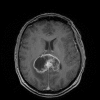Canine Butterfly Glioblastomas: A Neuroradiological Review
- PMID: 27458589
- PMCID: PMC4931820
- DOI: 10.3389/fvets.2016.00040
Canine Butterfly Glioblastomas: A Neuroradiological Review
Abstract
In humans, high-grade gliomas may infiltrate across the corpus callosum resulting in bihemispheric lesions that may have symmetrical, winged-like appearances. This particular tumor manifestation has been coined a "butterfly" glioma (BG). While canine and human gliomas share many neuroradiological and pathological features, the BG morphology has not been previously reported in dogs. Here, we describe the magnetic resonance imaging (MRI) characteristics of BG in three dogs and review the potential differential diagnoses based on neuroimaging findings. All dogs presented for generalized seizures and interictal neurological deficits referable to multifocal or diffuse forebrain disease. MRI examinations revealed asymmetrical (2/3) or symmetrical (1/3), bihemispheric intra-axial mass lesions that predominantly affected the frontoparietal lobes that were associated with extensive perilesional edema, and involvement of the corpus callosum. The masses displayed heterogeneous T1, T2, and fluid-attenuated inversion recovery signal intensities, variable contrast enhancement (2/3), and mass effect. All tumors demonstrated classical histopathological features of glioblastoma multiforme (GBM), including glial cell pseudopalisading, serpentine necrosis, microvascular proliferation as well as invasion of the corpus callosum by neoplastic astrocytes. Although rare, GBM should be considered a differential diagnosis in dogs with an MRI evidence of asymmetric or symmetric bilateral, intra-axial cerebral mass lesions with signal characteristics compatible with glioma.
Keywords: astrocytoma; brain tumor; canine; glioblastoma; magnetic resonance imaging.
Figures




References
Publication types
LinkOut - more resources
Full Text Sources
Other Literature Sources

